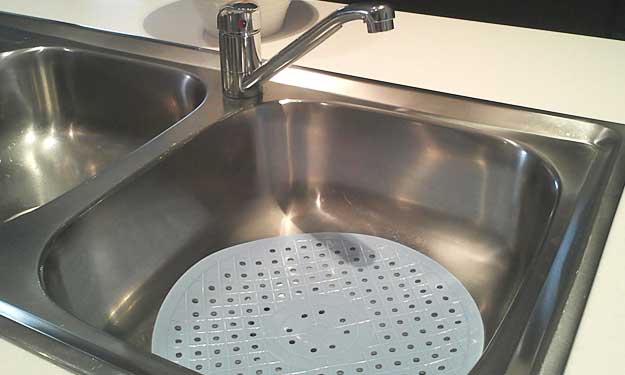Tips for Cleaning Stainless Steel Sinks

Cleaning Tips for Stainless Steel Sinks
Everyone I know (except for my kids) gets a little crazy when there is dirt or fingerprints on their stainless steel appliances.
I know that the smudges and streaks bother me, so I wipe down my stainless steel every night to keep it clean and shiny.
Our sinks take a beating every day. We toss silverware in the sink, we put hot pans in the sink to soak, and food gets dried and stuck on the surface and that’s something I don’t care to look at.
A dirty sink can really make the entire kitchen look dingy. This is never a place to neglect when cleaning especially when the kitchen can be the gathering place when you have family gatherings or company over.
How to Naturally Clean a Stainless Steel Sink on a Regular Basis
You probably bought a stainless steel sink because it is popular, durable, and goes with most home decors – so on that note – don’t neglect it.
Cleaning it each night can help keep it looking great for a long time. And you really don’t need to use a commercial product when you most likely have natural cleaning products in your home already.
When we’re done cleaning the dinner dishes, we give the sink a quick clean each night. All you need is a little baking soda and water.
Baking soda is abrasive enough to clean water spots, stuck on food particles, and it’s a natural deodorizer.
- While the sink is still wet, sprinkle a little baking soda in the sink.
- Use a soft, nylon brush, or if you don’t have that a dish rag will work, and scrub the whole sink. If the baking soda is a little too dry and clumping, add more water to make a paste.
- When you’re finished cleaning, rinse clean with water.
- To disinfect, pour white vinegar on some paper towel and wipe down. Or if you’re like me and keep a bottle of vinegar and water under the sink, spray the sink and wipe down.
- Dry with another piece of paper towel.
You’re done! And it only takes a few extra minutes.
Heavy Duty Stainless Steel Sink Cleaning
- In a container, mix 1 tablespoon coarse sea salt with 1/4 cup baking soda.
- Add 1/2 cup hydrogen peroxide. Stir well (it will make a bubbly paste).
- Use a sponge or dish rag to apply the paste to the sink area. Be sure to get in the crevices and don’t forget to clean the sink strainers.
- Allow the mixture to remain on the surface for 3-5 minutes.
- Using a toothbrush or soft scrub brush, make small, circular movements with the brush to remove dirt, grime, grease and stains.
- It can take some time to clean the sink if it has not been done regularly.
- Rinse the entire area with clean water.
- Dry using paper towels.
Shining Your Stainless Steel Sink
To give your stainless steel sink a nice shine follow up with this stainless steel cleaning tip.
- Apply a small amount of olive oil to a soft cloth.
- Rub the entire surface of the sink and faucet. Don’t use too much oil or the sink will look and feel oily and will attract dust and dirt.
- Fill a spray bottle with warm water and spray the sink area.
- Polish the sink with a Sham-Wow or other cloth until it shines. Now it will look like it was just installed in your kitchen.
Keeping Your Stainless Steel Sink Looking New
- To help keep your sink clean use a perforated rubber mat in the sink. This will cut down on scratching and marks that can be left by pans and tableware.
- Keep a small container in the sink where silverware, knives, rags or sponges can be deposited. I use an old Tupperware container. Before meals I add a couple drops of liquid dishwashing soap and some warm water to the bowl. By the time the dishes are put in the dishwasher, any stuck on food, rinses right off.
- Never use steel wool or harsh, abrasive cleaners as it can scratch the sinks surface.
- Don’t scrub against the grain lines, this will damage the original finish and could cause permanent scratching.
- You shouldn’t leave steel or cast iron cookware or implements on the surfaces for extended periods of time. This can cause corrosion and staining.

